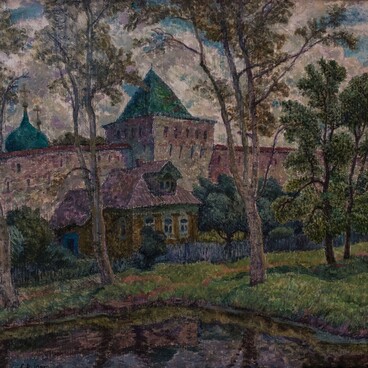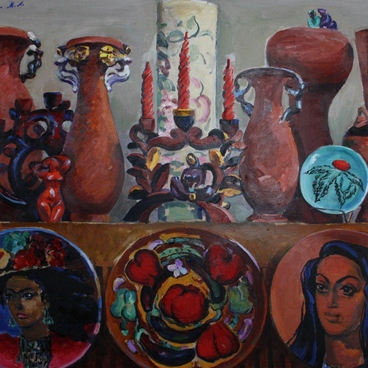Toivo Ryannel’s “Winter Hut on the Mana” is a part of the artist’s “Mana series”. Ryannel depicted a small hut, made of logs, against the background of the impenetrable Siberian taiga in early spring. The mountain river Mana with bushes on its banks can be seen in the background, and a dense coniferous forest stands in the distance.
In Siberia, a winter hut is a small wooden dwelling built in the taiga or tundra far from populated areas. Most often winter huts are built on the banks of forest streams or along roads that are seldom used. Hunters and fishermen take shelter in winter huts during winter fishing. Most often such huts are empty and unguarded; one can find there a small supply of food, wait out the bad weather or hide from predators.
While working on the “Mana series”, Toivo Ryannel explored the Sayan Mountains and upper reaches. He traveled on foot, on a raft and on a boat, and ventured into the wilds of the taiga in order to convey the peculiarities of the region as accurately as possible in his works.
In Siberia, a winter hut is a small wooden dwelling built in the taiga or tundra far from populated areas. Most often winter huts are built on the banks of forest streams or along roads that are seldom used. Hunters and fishermen take shelter in winter huts during winter fishing. Most often such huts are empty and unguarded; one can find there a small supply of food, wait out the bad weather or hide from predators.
While working on the “Mana series”, Toivo Ryannel explored the Sayan Mountains and upper reaches. He traveled on foot, on a raft and on a boat, and ventured into the wilds of the taiga in order to convey the peculiarities of the region as accurately as possible in his works.
Paintings from the “Mana series” are distinctly generalized landscapes: a small part symbolizes the entire Krasnoyarsk taiga region. Broad strokes helped Ryannel to eliminate unnecessary fragmentation and detail in the paintings.
In these works, the artist’s desire to use large-scale format arose: he preferred to create landscape compositions with the help of large volumes and planes.
The image of Mana’s nature in the painting “Winter Hut on the Mana” is made up of the rushing river currents, massive centuries-old trees and huge boulders, while the sky occupies quite an insignificant place in it.
Toivo Ryannel was born in 1921 in Ladoga, in the village of Tozerovo, Petrograd Governorate. His parents were simple Ingermanlandian peasants. In April 1931, Ryannel’s family was repressed and exiled to the Udereisky (nowadays Motyginsky) district of Krasnoyarsk Krai.
In 1939, by special permission of the special commander’s office, Ryannel entered the Omsk Art School, where he studied until his third year, until in 1941 he was mobilized to the front. Ryannel was soon recalled from the army.
In 1946, the artist moved to Krasnoyarsk and soon joined the Artists' Union of the USSR. In 1974, Ryannel was awarded the title of Honored Artist of the RSFSR, and in December 20, 1991 — the People’s Artist of the RSFSR. He lived in Siberia until 1995, when he moved to Finland as a repatriate. Toivo Ryannel died in 2012 in Vantaa.
Ryannel’s works are displayed in art museums in Russia, in private collections in Japan, China, USA, France, Germany, South Africa, Sweden, and Finland. More than a hundred paintings are housed in the Vasily Surikov Krasnoyarsk State Art Museum.
In these works, the artist’s desire to use large-scale format arose: he preferred to create landscape compositions with the help of large volumes and planes.
The image of Mana’s nature in the painting “Winter Hut on the Mana” is made up of the rushing river currents, massive centuries-old trees and huge boulders, while the sky occupies quite an insignificant place in it.
Toivo Ryannel was born in 1921 in Ladoga, in the village of Tozerovo, Petrograd Governorate. His parents were simple Ingermanlandian peasants. In April 1931, Ryannel’s family was repressed and exiled to the Udereisky (nowadays Motyginsky) district of Krasnoyarsk Krai.
In 1939, by special permission of the special commander’s office, Ryannel entered the Omsk Art School, where he studied until his third year, until in 1941 he was mobilized to the front. Ryannel was soon recalled from the army.
In 1946, the artist moved to Krasnoyarsk and soon joined the Artists' Union of the USSR. In 1974, Ryannel was awarded the title of Honored Artist of the RSFSR, and in December 20, 1991 — the People’s Artist of the RSFSR. He lived in Siberia until 1995, when he moved to Finland as a repatriate. Toivo Ryannel died in 2012 in Vantaa.
Ryannel’s works are displayed in art museums in Russia, in private collections in Japan, China, USA, France, Germany, South Africa, Sweden, and Finland. More than a hundred paintings are housed in the Vasily Surikov Krasnoyarsk State Art Museum.

